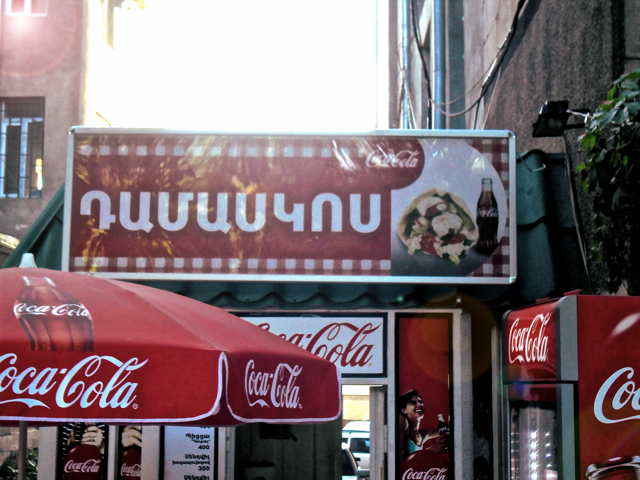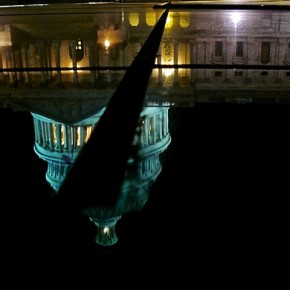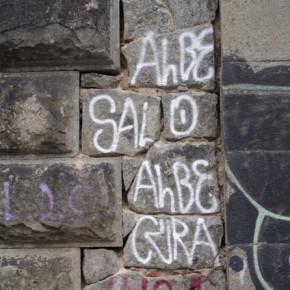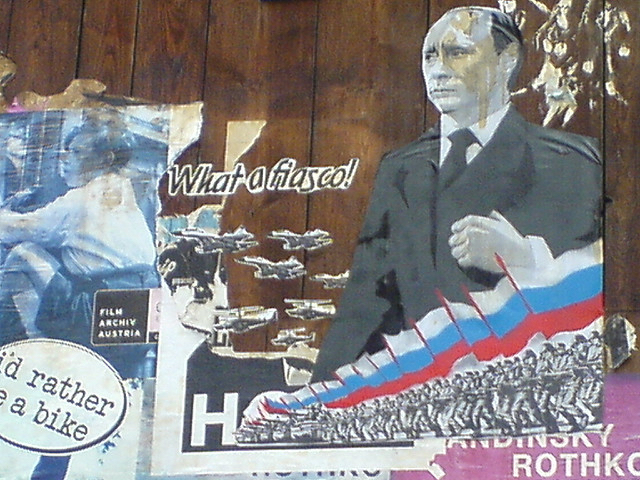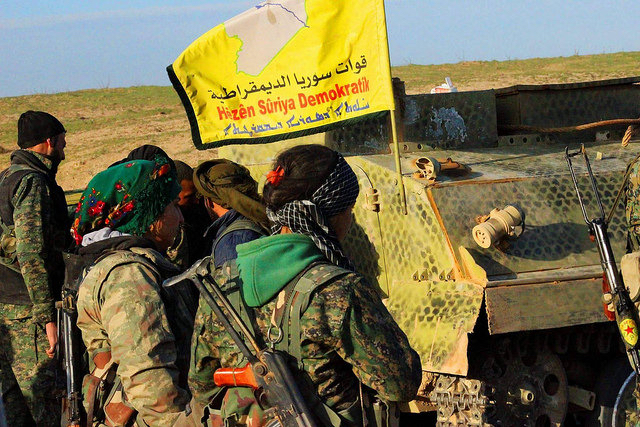The Aleppo Kebab Stall is a small, corrugated plastic booth slightly larger than its occupants, and only slightly narrower than the alleyway where it stands, in Yerevan. Barely avoiding the oncoming traffic, I crossed the street and squinted at the shop sign, miming the letters to myself in an attempt to decode the name. Ha-lep. Aleppo. Braving a heady perfume of cigarette smoke and shawarma, I poked my head through the window, and ordered.
A friendly moustachioed face emerged, and we looked at each other in smiling confusion: an Armenian in his fifties who does not understand Russian is unlikely to have been born in Soviet Armenia. Perhaps, I supposed, a Syrian?
I have only lived in Yerevan for seven weeks, long enough to form baseless generalisations, but too short to have them rudely disproved. Several shawarmas into my stay, this assumption appears to be a reasonable one. The number of Syrian Armenians now living in the Republic of Armenia is estimated to be nearly 10,000 – quite a large intake for a country of three million with high levels of emigration.
Kebab stalls aside, the government has even funded the construction of a “New Aleppo” for them. Syrian-Armenian families have been settled in the disputed region of Nagorno-Karabakh, including regions of the unrecognised republic which lie outside the borders of Soviet-era Karabakh, leading Azerbaijan Foreign Minister Mammadyarov to describe the settlement as evidence of Armenia’s intention to annex these regions. A small number of Circassians have left Syria for their ancestral homelands in the Russian North Caucasus, whilst Abkhazia – where ethnic Abkhaz have a very slim majority – has seen the arrival of fewer than 500 Abkhaz refugees. The numbers may be small, but this is the Caucasus, and demographics matter.
For the attentive – the attentive without Armenian language skills, that is – there are a few signs in Yerevan’s city centre that hint at the city’s new residents. Syrian car numberplates are not an unfamiliar sight, and flyers advertise used cars for sale, likely of the same vehicles that drove here across Turkey, and then through Georgia or Iran. Other Arabic flyers offer apartments not far from the city centre at good rates. In Glendale Hills, a housing development funded partly by the Armenian-American community of California, I met by chance a family of refugees from Aleppo. The television murmured in the corner, the six Syrians sipped tea, and the Russian-Armenian landlord with a hundred decibel laugh (and a thousand decibel shirt) apologised with hand on heart: “Had you been here two days earlier, I would have let the place to you, but these here are from Aleppo. As an Armenian I have a duty to fulfill. I’ll let them rent it. Cheaply.”
It has become easier for Syrian Armenians to apply for Armenian citizenship and receive passports. Armenian citizens fleeing Syria are often not counted among the number of Syrian-Armenian refugees entering the country. Armenia’s Diaspora Ministry states that some 15,000 people were granted dual citizenship in 2012, though whether dual citizenship necessarily implies permanent repatriation is another question. According to Armenia’s National Statistical Service, from January to June 2013, 2,281 citizens of the Syrian Arab Republic entered Armenia, and 1,201 Syrian citizens left, compared to 8,396 Syrian citizens entering Armenia in 2012 and 4,044 leaving during the same period in 2012. As the conflict in Syria intensifies, leaving the country for Armenia has become riskier – the overland journey from Aleppo to Yerevan by car, noted Levon, has become untenable. From September 2012 to January 2013, increasing numbers of flights from Aleppo to Yerevan were cancelled as air carriers could no longer guarantee their passengers’ safety and Turkey banned civilian flights from Syria over its territory. “Armenia,” as one analyst put it, “offers [Syrian-Armenians] immediate stability and safety, but nothing more.”
The Kololian Foundation’s Study on the demographic crisis in Armenia, released this month, showed through interviews of a sample group of Syrian Armenians that 73% of the new arrivals are from Aleppo and 9% from Damascus. They are also educated – 77% have a degree, yet given Armenia’s economic climate, only 59% are now employed (compared to 68% who were employed before coming to Armenia.) With winter setting in, war continuing, and refugees’ resources dwindling, concern has already been raised as to the fate of the still homeless and unemployed among their numbers. Whether they will be prepared to return to Syria if and when peace comes is a question of who will emerge victorious.

From the high iron fence around the Syrian (Arab Republic’s) Embassy on Yerevan’s Marshal Baghramyan Avenue, a government flag hangs in solemn triumph. Syria’s Armenians, like many of the country’s Christian communities, were generally perceived as being pro-status quo and sometimes pro-regime, yet it is said (with some exceptions) those in Armenia are ambiguous about openly stating their loyalties, should they someday leave their homeland to return to their homes. Indifference is sometimes the best camouflage.
Back in the four plastic walls of Aleppo, Levon – owner and Za’atar afficionado – bared his meat cleaver and his soul, and started to talk. Drawing an outline map of the Near East on a stained piece of greaseproof paper, he stabbed a finger into the far northeast of Syria, which I could tentatively have named “Kurdistan.” We had had a few brief exchanges once over lunch in Aleppo, but nothing too political. “I know an Alawite from Latakia who makes a Kenafe to die for,” (“difficult to find in Yerevan,” sighed Levon), but precious little of Syria beyond the headlines. “Al-Qamishli,” Levon declared (as indicated by ketchup stain, scale unknown) “is closer to Yerevan than to Damascus.” His namesake, Armenia’s first post-Soviet President Levon Ter-Petrossian, was also Aleppine, he was proud to point out. “I used to have a hotel. Now I make your kebab,” he added, in what could have been either a comparison or a statement of fact. With a daughter in Canada, two houses, and an olive garden left behind in Syria, brighter prospects for Levon appeared out of reach. As did the lavash. He slapped it down on the greaseproof map of Syria. The ketchup-and-mayonnaise cities did not survive.
“The war,” he declared “is a war between Muslims.” He spread the kebab meat over the bread with a flick of the wrist. “Armenians just want peace.” Would he go back?
“No, too much blood. Too much blood … They cut the Christian’s head.” He set the meat cleaver down on the counter, gracefully rolled up the shawarma and presented it to me. The greaseproof map was visible once more. “Armenians just want peace. Don’t care about Assad, don’t care about rebels.”
And in Yerevan? At the outset, there were some communication problems. Armenians are Armenians. Yet Western Armenian, the language of Syria’s Armenian community, and the Eastern Armenian of the Republic of Armenia, have their differences. “Western Armenians come from Cilicia. It was an Armenian Kingdom, you know where Cilicia is?” The mirror on the wall doubled the number of customers – a modest queue had formed behind me. And that was when I said the unsayable. “Sure – Antakya… it’s southeast Turkey, right?”
Levon raised his eyebrows and lifted a finger heavenwards. I sputtered an apology and Levon, finger wagging, nearly lost equilibrium. I felt ashamed; I really should have known better.
“TURKEY? No, what is Turkey? What does it mean, Turkey?”
“Sorry, I mean… Western Armenia, Greece, Kurdistan?”
“No, no – what does Turk mean? You have a dictionary?” (I didn’t.)
Levon stared at me. I shrugged.
“Turk, Turcoman, it means… somebody who has left their home.
…to live on somebody else’s land.”
Photographs courtesy of the author
